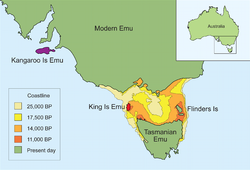D. n. minor
| King Island emu | |
|---|---|
 |
|
| 1907 illustration by John Gerrard Keulemans, based on the Paris skin | |
| Scientific classification | |
| Kingdom: | Animalia |
| Phylum: | Chordata |
| Class: | Aves |
| Superorder: | Paleognathae |
| Order: | Casuariiformes |
| Family: | Dromaiidae |
| Genus: | Dromaius |
| Species: | D. novaehollandiae |
| Subspecies: | †D. n. minor |
| Trinomial name | |
|
Dromaius novaehollandiae minor (Spencer, 1906) |
|
 |
|
| Geographic distribution of emu taxa and historic shoreline reconstructions around Tasmania, D. n. minor in red | |
| Synonyms | |
|
List
|
|
The King Island emu (Dromaius novaehollandiae minor) is an extinct subspecies of emu that was endemic to King Island, which is situated in the Bass Strait between mainland Australia and Tasmania. Its closest relative may be the extinct Tasmanian emu (D. n. diemenensis), as they belonged to a single population until less than 14,000 years ago, when Tasmania and King Island were still connected. The small size of the King Island emu may be an example of insular dwarfism.
The King Island emu was the smallest of all emus, and had darker plumage than the mainland emu. It was black and brown, and had naked blue skin on the neck, and its chicks were striped like those on the mainland. The subspecies was distinct from the likewise diminutive Kangaroo Island emu (D. baudinianus) in a number of osteological details, including size. The behaviour of the King Island emu probably did not differ much from that of the mainland emu. The birds gathered in flocks to forage and during breeding time. They fed on berries, grass and seaweed. They ran swiftly, and could defend themselves by kicking. The nest was shallow, and consisted of dead leaves and moss. Seven to nine eggs were laid, which were incubated by both parents.
Europeans discovered the King Island emu in 1802 during early expeditions to the island, and most of what is known about the bird in life comes from an interview French naturalist François Péron conducted with a sealer there, as well as depictions by artist Charles Alexandre Lesueur. They had arrived on King Island in 1802 with Nicolas Baudin's expedition, and in 1804 several live and stuffed King and Kangaroo Island emus were sent to France. The two live King Island specimens were kept in the Jardin des Plantes, and the remains of these and the other birds are scattered throughout various museums in Europe today. The logbooks of the expedition did not specify from which island each captured bird originated, or even that they were taxonomically distinct, so their status remained unclear until more than a century later. Hunting pressure and fires started by early settlers on King Island likely drove the wild population to extinction by 1805. The two captive specimens in Paris both died in 1822 and are believed to have been the last of their kind.
...
Wikipedia

